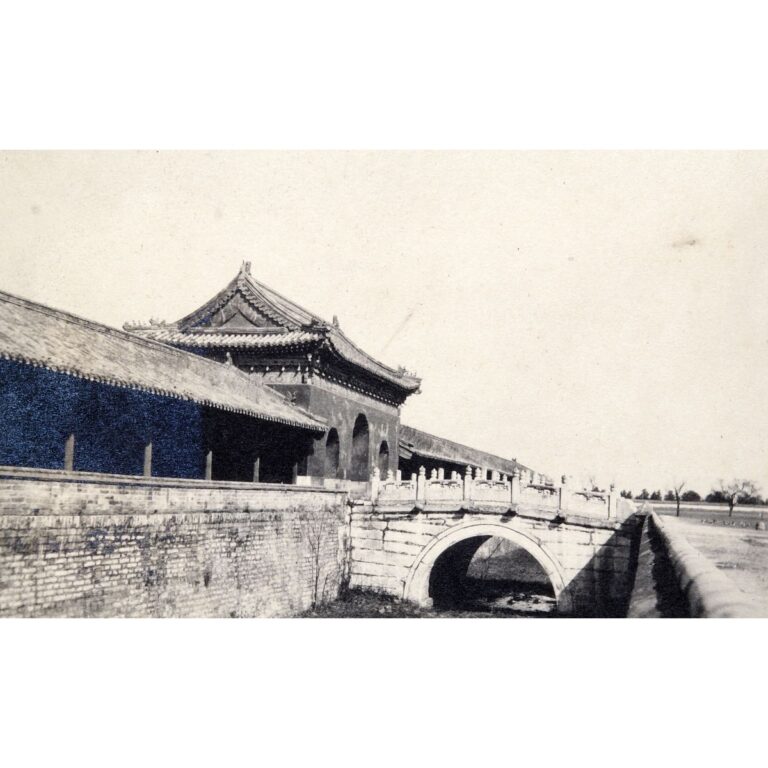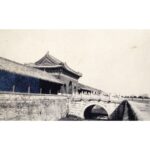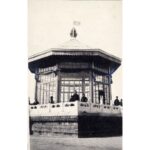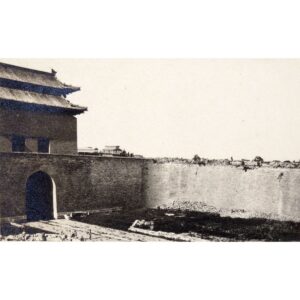Photography Entrance to the Temple of Heaven
A black-and-white photograph showing a side view of the entrance to the 273-hectare Temple of Heaven complex (Tiantan 天壇) in Beijing. It was built in 1420 by the Yongle emperor (reigned 1402–1424). Here the emperors of the Ming and Qing dynasties held ceremonies of celestial worship at the summer and winter solstices. The entrance was built using the traditional Chinese construction technique, the dougong 斗拱 system. The way to the entrance is through a shorter arched bridge with a balustrade made of white hanbai yushi 漢白玉石 marble and rich reliefs. The motif on the panels and column finials is a five-headed dragon (wu jiao jin long 五爪金龍), symbolising the absolute power of the emperor. Carefully carved dragons intertwine with clouds, their heads protruding from the wall below the balustrade.
The Temple of Heaven complex is now located in the southeastern part of Beijing. It was originally called the “Temple of Heaven and Earth” and had only ... more
A black-and-white photograph showing a side view of the entrance to the 273-hectare Temple of Heaven complex (Tiantan 天壇) in Beijing. It was built in 1420 by the Yongle emperor (reigned 1402–1424). Here the emperors of the Ming and Qing dynasties held ceremonies of celestial worship at the summer and winter solstices. The entrance was built using the traditional Chinese construction technique, the dougong 斗拱 system. The way to the entrance is through a shorter arched bridge with a balustrade made of white hanbai yushi 漢白玉石 marble and rich reliefs. The motif on the panels and column finials is a five-headed dragon (wu jiao jin long 五爪金龍), symbolising the absolute power of the emperor. Carefully carved dragons intertwine with clouds, their heads protruding from the wall below the balustrade.
The Temple of Heaven complex is now located in the southeastern part of Beijing. It was originally called the “Temple of Heaven and Earth” and had only one venue, a square platform with a circular temple called Qinian Hall (Qiniandian 祈年殿) or “Hall of Annual Prayers”. It was originally intended for earth worship rituals, but today it is the oldest and most iconic part of the entire complex. In the 16th century, a decision was taken to perform the rituals for heaven and Earth separately. Thus, the complex was renamed, and separately from the Qinian Hall, two more sites for the worship of heaven were added. The last emperor to bow to heaven in the Temple of Heaven was Yuan Shikai 袁世凱 (reigned 1915–1916), who for several months tried in vain to revive the monarchy. This marked the end of a centuries-old tradition. Today, the Temple of Heaven is on the UNESCO World Cultural Heritage List, as it is the largest religious complex in the world.
The photograph is the 188th of 449 photographs of Beijing and its surroundings in the album of Ivan Skušek Jr., purchased during his stay in Beijing (1914–1920). In the handwritten inventory of the album, the photograph is referred to as Himmels-Tempel: Tor und Brücke ( Seiten-Ansicht ). (DZ, MV)





































Do you have a comment or additional information about the subject?